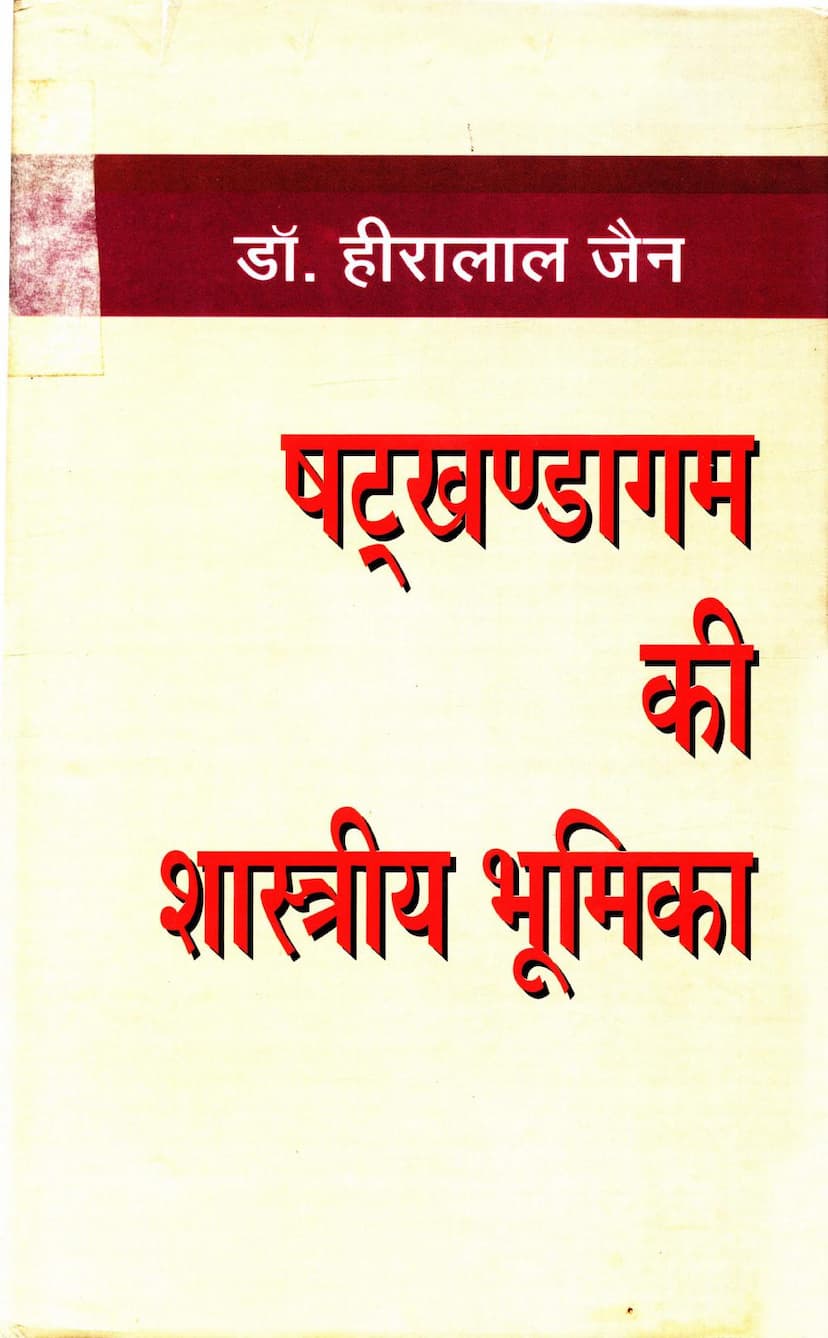Shatkhandagam Ki Shastriya Bhumika
Added to library: September 2, 2025

Summary
This is a comprehensive summary of the Jain text "Shatkhandagama ki Shastriya Bhumika" by Hiralal Jain, based on the provided page scans:
Book Title: Shatkhandagama ki Shastriya Bhumika (A Scholarly Introduction to Shatkhandagama) Author: Hiralal Jain Publisher: Prachya Shraman Bharati, Muzaffarnagar
This book is a detailed scholarly introduction to the Shatkhandagama, a fundamental text in Digambara Jainism. The introduction provides historical, philosophical, linguistic, and scientific context for this significant scripture.
Overview:
The book is presented as a tribute to Dr. Hiralal Jain, a renowned scholar of Jain principles, Sanskrit, Prakrit, and Apabhramsa language and literature. His work on the Shatkhandagama and its commentary, Dhavala, is considered a monumental achievement, dedicating twenty years of his life and the life of his wife to its meticulous editing and translation. The publication commemorates his birth centenary.
Key Aspects of the Shatkhandagama and its Introduction:
-
Historical Context:
- The Shatkhandagama is presented as a foundational Jain scripture, stemming from the ancient tradition of "Purva" texts.
- It was originally compiled by Acharya Dharasena, who taught portions of the fifth Anga (Viahapannatti) and the twelfth Anga (Ditthivada) to his disciples Pushpadanta and Bhutabali.
- Pushpadanta composed the first 177 sutras, and Bhutabali completed the remaining 6000 sutras, dating the Shatkhandagama to around the 1st-2nd century CE.
- The text deals with Karma philosophy, divided into six sections: Jivatthana (Soul States), Khuddabandha (Minor Bondage), Bandha-swamitva-vichaya (Karma Bondage Ownership Analysis), Vedana (Karma Experiences), Vargana (Karma Aggregate), and Mahabandha (Major Bondage).
-
The Dhavala Commentary:
- The primary commentary available on the Shatkhandagama is the Dhavala, written by Acharya Virasena.
- Virasena completed the Dhavala, which is approximately 72,000 verses long, in Saka 738 (816 CE).
- The Dhavala's importance lies in its detailed explanations, scholarly annotations, comparative studies with other philosophical systems, and linguistic analysis of the Prakrit used.
- Dr. Hiralal Jain's monumental work involved editing and publishing the Shatkhandagama and its Dhavala commentary in sixteen volumes, providing Hindi translations, critical analyses, and extensive introductions.
-
Dr. Hiralal Jain's Contribution:
- Dr. Jain's extensive research on the Shatkhandagama and its Dhavala spanned twenty years.
- His work included philological analysis, critical review of manuscripts, comparison of texts, and providing detailed historical and philosophical introductions to each of the sixteen volumes.
- He emphasized the scientific nature of Jain philosophy and the preservation of ancient Indian knowledge through the Shramana tradition.
- The publication of this introduction is part of a larger effort to honor his legacy and make this profound knowledge accessible.
-
Structure of the Introduction:
- The book "Shatkhandagama ki Shastriya Bhumika" itself is a compilation of Dr. Hiralal Jain's substantial introductions written for each of the sixteen volumes of the Shatkhandagama.
- It includes a preface (Praakathan), a detailed introduction to the Shatkhandagama in English, and then presents the "Shastriya Bhumika" (Scholarly Introduction) section by section, corresponding to the six Khandas of the Shatkhandagama.
- It also includes appendices with Dr. Hiralal Jain's biographical information, important historical figures, and a glossary of technical terms from the Shatkhandagama.
-
Key Scholarly Themes Explored:
- Jain Canon (Agama): Discussion of the twelve Angas, the fourteen Purvas, and the loss of much of the ancient canon.
- Jain Philosophy and Principles: Detailed explanation of the Shatkhandagama's core teachings on soul, karma, stages of spiritual progress, and ethical conduct.
- Linguistic Analysis: Exploration of the Prakrit language (Sauraseni, influenced by Ardha Magadhi and Maharashtri) used in the sutras and commentaries, and the shift towards Sanskrit in later periods.
- Textual Criticism and Editing: The immense challenges of editing ancient texts with corrupt manuscripts, the reliance on multiple manuscript traditions, and the process of establishing a critical text.
- Historical Background: Tracing the lineage of Acharyas from Mahavira to Virasena, Puspadanta, and Bhutabali, and the dating of these texts.
- Mathematical and Astronomical Content: The Dhavala commentary, in particular, is noted for its intricate mathematical calculations and astronomical details, reflecting the scientific knowledge of ancient India. The introduction highlights Dr. Jain's expertise in these complex areas.
- Comparison of Traditions: Mention of the need for comparative study with other Indian philosophical and religious traditions, including Vedic and Buddhist literature, and Western philosophical systems.
- Revival and Preservation: The efforts made to recover and preserve these invaluable Jain scriptures, which were in danger of being lost due to neglect and the deterioration of palm-leaf manuscripts.
- Dr. Hiralal Jain's Life and Work: The book emphasizes the dedication and sacrifice involved in Dr. Jain's life's work, highlighting his intellectual prowess and his commitment to making the vast knowledge of the Shatkhandagama accessible.
In essence, "Shatkhandagama ki Shastriya Bhumika" is more than just an introduction; it's a profound exploration into the intellectual and spiritual heritage of Jainism, meticulously presented through the lens of Dr. Hiralal Jain's unparalleled scholarship. It serves as a vital resource for understanding the depth, complexity, and historical significance of the Shatkhandagama within the broader context of Indian philosophy, language, and science.